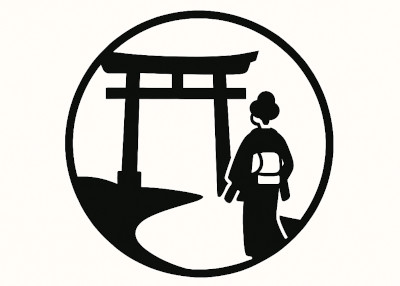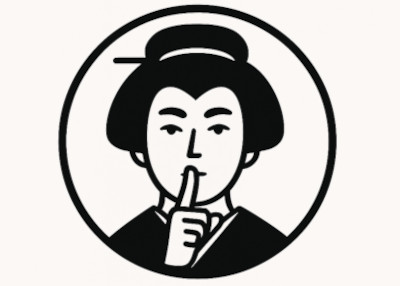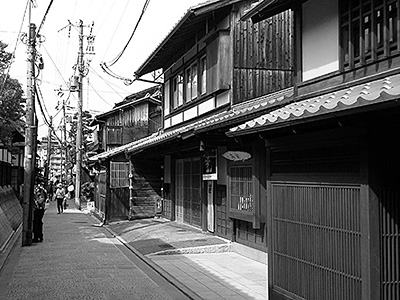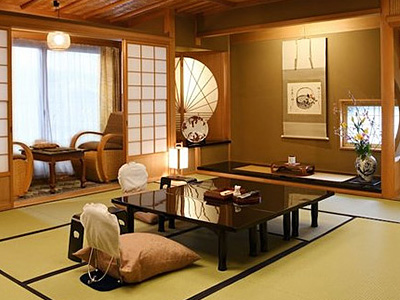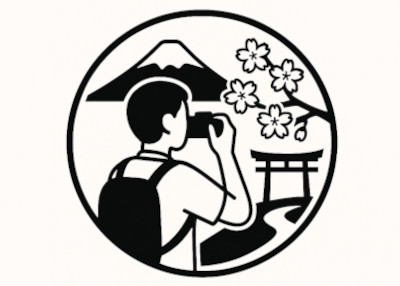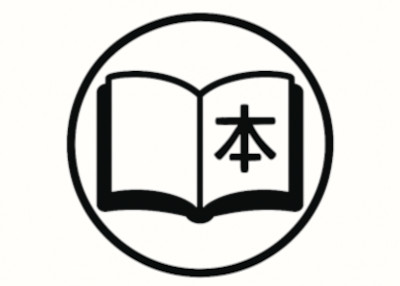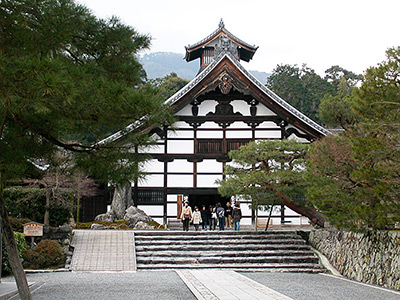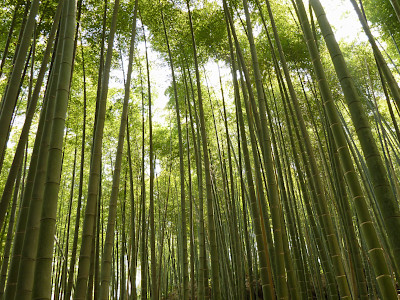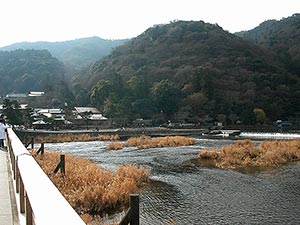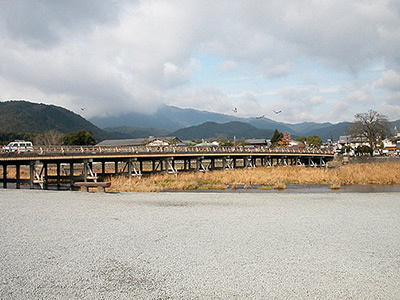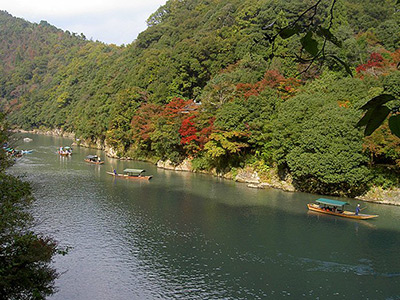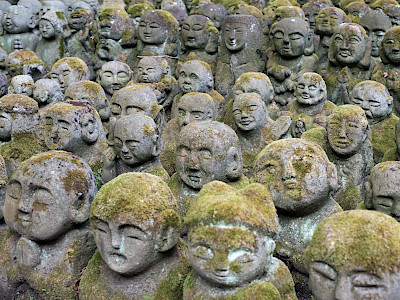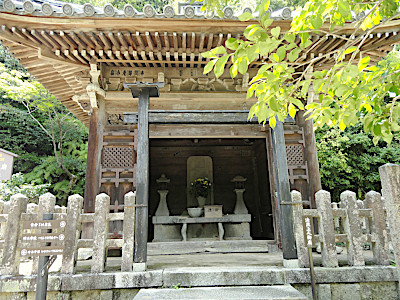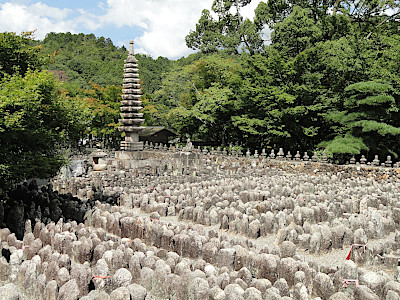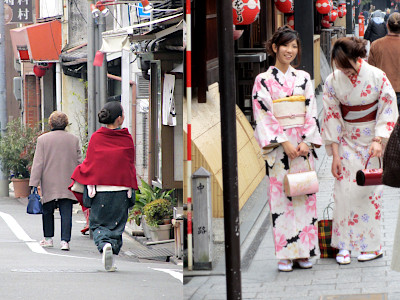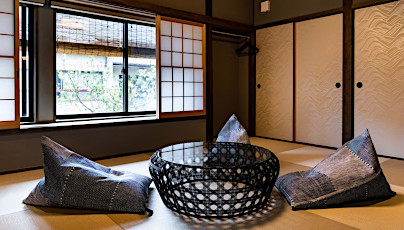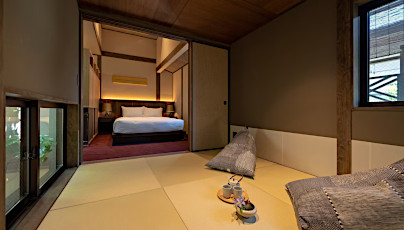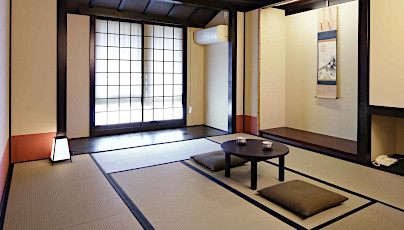Rakushisha Residence in Arashiyama in Kyoto
This post can contain affiliate links, which means that we may receive a small commission if you make a purchase using these links.
Facts & Figures
Rakushisha (literally "Hut of Fallen Persimmons") in Kyoto was the home of poet Mukai Kyorai (1651 – 1704), a chief disciple out of ten main disciples of the great poet and haiku master Matsuo Basho (1644 – 1694). Rakushisha Residence, also called Rakushisha Poet’s Hut, is famous in the world of haiku (traditional Japanese poetry).
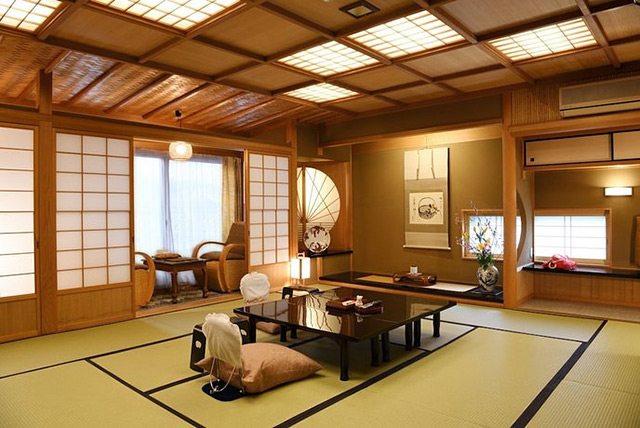 Experience the Ultimate Japanese Hospitality at a Kyoto Ryokan.
Experience the Ultimate Japanese Hospitality at a Kyoto Ryokan.
Find Your Perfect Ryokan Now >
The construction materials of the cottage are elementary. Clay was used for the walls and the roof is made of thatch. The building contains only a few rooms and a small kitchen. Look out for stone slabs in the garden with haiku from Matsuo Basho and Mukai Kyorai engraved on them. At this property, Basho wrote in 1691 his famous Saga Nikki (Saga Diary).
- Rakushisha Residence or Rakushisha Poet’s Hut:
- Opening Hours - 10:00 am to 4:00 pm (January to February)
- Opening Hours - 9:00 am to 5:00 pm (rest of the year)
- Closed - 31st of December and 1st of January
- Admission fee - 300 yen (Adults), free (Children)
History
When Mukai Kyorai (1651 – 1704), the son of a wealthy physician from Nagasaki, turned 27 he went into seclusion and decided later to build this residence during the Edo Period (1603 to 1868). There is this interesting story that after a very stormy night, Mukai Kyorai woke up in the morning and saw that on his property nearly all persimmons had fallen from the in total 40 trees. At this moment he decided to call his place Rakushisha - Hut of Fallen Persimmons. His master Matsuo Basho (1644 – 1694) visited him 3 times at this place. During one of his stays, he wrote this famous haiku:
summer rain
on the wall traces
of torn poem cards
After the death of Kyorai, the Rakushisha Residence became uninhabitable and was destroyed in 1704. In 1770 followers of Kyorai rebuilt the cottage.
Location

Rakushisha is located within the Arashiyama district near the Katsura River in the western outskirts of Kyoto.
Address: 20 Sagaogurayama Hinomyojincho, Ukyo Ward, Kyoto, 616-8391, Japan
How to get to Rakushisha?
- 15min from Kyoto Station to Saga-Arashiyama Station by JR Sagano Line and
- 15min from Saga-Arashiyama Station to Rakushisha
Sightseeing spots at Rakushisha
Top:
Inside the house - The walls are covered with ink-brushed poems and on the floor you will find stone tablets with haiku inscribed.
Thatched roof - The roof was assembled without using any nails.
Grave of Mukai Kyorai - The tomb is located near the property at the Kogen-ji temple grounds - a sub temple of Tenryu-ji.
Small garden - You will see there many stones with engraved poems and forty persimmon trees.
Festival & Events (dates can change without notice)
February
Setsubun (3rd)
One day before spring arrives (lunar calendar) the Setsubun is celebrated. Bean-throwing (Mame maki) ceremonies are held at the shrine to get good fortune for the year. Do not miss the bonfire in the evening.
April
Miyako Odori (1st - 31th)
The traditional annual spring dance of the Kyoto district Gion Kobu performed by Geiko and Maiko is a must-see on your Kyoto visit. Don't miss the most popular dances the Miyako Odori "Cherry Blossom Dances" or "Dances of the Old Capital" at the Gion Kobu Kaburenjo Theater (located close to Gion Corner).
May
Ochatsubo Dochu (1st)
The Ochatsubo Dochu or Traveling Tea Canisters festival dates back to the Edo Period. It represents the practice of showing the new tea harvest from Uji to the ruling shogun in the old days. Now during the parade large ceramic containers with tea are carried by people wearing traditional costumes from Kenninji Temple to Yasaka Shrine.
Aoi Matsuri (15th)
The highlight of this festival is a large parade from the Imperial Palace through the Shimogamo Shrine to the Kamigamo Shrine. More than 500 people wearing aristocratic costumes from the Heian Period (794 - 1185). The Aoi Matsuri belongs with the Gion Matsuri and Jidai Matsuri as the three most famous festivals in Kyoto.
July
Gion Matsuri (whole month)
The month of July is full of different events like the Yoiyama - Kyoto's Magical Night (locals in kimonos look at the giant Gion floats the day before the parade) or the famous Yamaboko Junko (float procession on the 17th of July).
October
Jidai Matsuri ("Festival of Ages") (22nd)
People celebrate with a large parade between Imperial Palace to Heian Shrine the anniversary of the foundation of Kyoto. App. 2000 participants wearing historical costumes from different time periods. Enjoy this great festival which lasts around 2 hours.
November
Shichi-Go-San (15th)
The well-being and growth of young children are celebrated at the shrine and in the rest of Japan.
Where to stay in Kyoto?
Book your Flight Tickets and Rental Car for your Japan trip
Day trips from Kyoto:
Travelers who viewed Rakushisha Residence viewed also:
Top rated - Best Machiya Houses in Kyoto
THE MACHIYA Ebisuya, 192 Ebisuya-cho Shimogyo-ku, Kyoto 600-8062
This 3-star guesthouse got an excellent rating. All 30 individually furnished rooms offer free WiFi, air conditioning, bathrooms incl. toilets, fridges, 40-inch flat-screen TVs, and more. THE MACHIYA Ebisuya is located in central Kyoto.
View on Expedia.com
This 3-star guesthouse got an excellent rating. All 30 individually furnished rooms offer free WiFi, air conditioning, bathrooms incl. toilets, fridges, 40-inch flat-screen TVs, and more. THE MACHIYA Ebisuya is located in central Kyoto.
View on Expedia.com
The Machiya Kazahaya, 570-6 Kazahayacho, Shimogyo-ku, Kyoto, Kyoto, 600-8475
The Machiya Kazahaya offers for all guest rooms free WiFi, air conditioning, safes, bathrooms with toilets, refrigerators, and much more. Enjoy also the beautiful Japanese Garden. Guests gave this property the rating - Exceptional.
View on Expedia.com
The Machiya Kazahaya offers for all guest rooms free WiFi, air conditioning, safes, bathrooms with toilets, refrigerators, and much more. Enjoy also the beautiful Japanese Garden. Guests gave this property the rating - Exceptional.
View on Expedia.com
Kyomachiya Ryokan Sakura Urushitei, 425 Kichimonjicho, Shimogyo-ku, Kyoto, 600-8069
This beautiful 3-star guesthouse offers 32 rooms with free WiFi, air conditioning, bathrooms incl. showers and toilets, refrigerators, and much more. Enjoy also the relaxing indoor public bath (no minerals). Guests gave this property the rating - Wonderful.
View on Expedia.com
This beautiful 3-star guesthouse offers 32 rooms with free WiFi, air conditioning, bathrooms incl. showers and toilets, refrigerators, and much more. Enjoy also the relaxing indoor public bath (no minerals). Guests gave this property the rating - Wonderful.
View on Expedia.com





